Rice fields in Vietnam transform ordinary landscapes into extraordinary masterpieces that captivate travelers from around the world. These stepped agricultural wonders aren’t just vital food sources but living works of art that change with each season. At Phieu Travel, we’ve guided countless visitors through these emerald treasures, watching their faces light up at first sight of valleys draped in golden terraces. The perfect harmony between human ingenuity and nature’s canvas creates an experience that transcends typical sightseeing and connects visitors to Vietnam’s cultural heart.
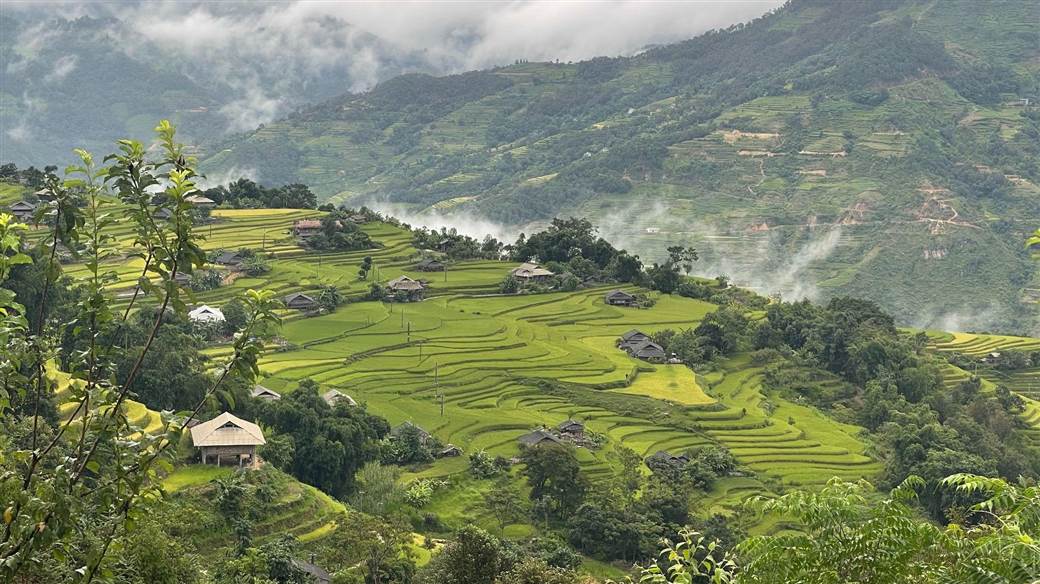
1. Why Vietnam’s Rice Terraces Deserve Your Attention
The rice terraces of Vietnam represent centuries of agricultural innovation and cultural heritage. These structures are more than farming systems. They are architectural marvels that reflect the deep relationship between Vietnam’s ethnic communities and their environment. Developed over generations through countless hours of manual labor, these cascading fields have shaped both the physical landscape and cultural identity of northern Vietnam.
1.1 Cultural Significance and Engineering Feats
Vietnam’s terraced rice fields tell a story of remarkable human adaptation. Ethnic minority groups, primarily the H’mong, Dao, Tay, and Giay people, transformed steep mountain slopes into productive agricultural land through ingenious engineering. Using only basic tools and knowledge passed through generations, these communities carved flat platforms into mountainsides and developed sophisticated irrigation systems that distribute water evenly across every level. This traditional wisdom has sustained communities for centuries in challenging terrain where conventional farming would be impossible.
The rice terraces represent more than agricultural space they embody the spiritual and cultural life of highland communities. Many ethnic groups mark their agricultural calendar with important ceremonies and festivals that honor mountain deities and ancestors believed to protect their harvests. The shared labor of maintaining these complex systems strengthens community bonds and preserves traditional knowledge. When visiting with Phieu Travel guides, you’ll learn how each community has its own distinct techniques for construction, irrigation, and cultivation, reflecting their unique cultural identity and environmental understanding.
1.2 A Photographer’s Dream Landscape
For photographers and nature lovers, Vietnam’s rice terraces offer an ever-changing canvas that transforms dramatically with the seasons. The terraces create natural amphitheaters that capture light in unique ways throughout the day. Morning mist clings to valley floors while terraces emerge like islands in a cloud sea. Golden hour bathes the rippling landscape in warm light that highlights every curve and contour of the mountainsides. These moments create photography opportunities that have graced countless magazine covers and social media feeds.
Each season presents a completely different visual experience. Spring brings newly flooded fields that transform terraces into reflective mirrors capturing perfect sky reflections. Summer reveals lush green carpets climbing mountainsides in perfect symmetry. Autumn delivers the iconic golden harvest scenes that seem to glow from within. Even winter has its charm with bare terraces revealing their sculptural bone structure. The dynamic landscape ensures that no two visits and no two photographs will ever be identical, making these destinations worth returning to again and again.
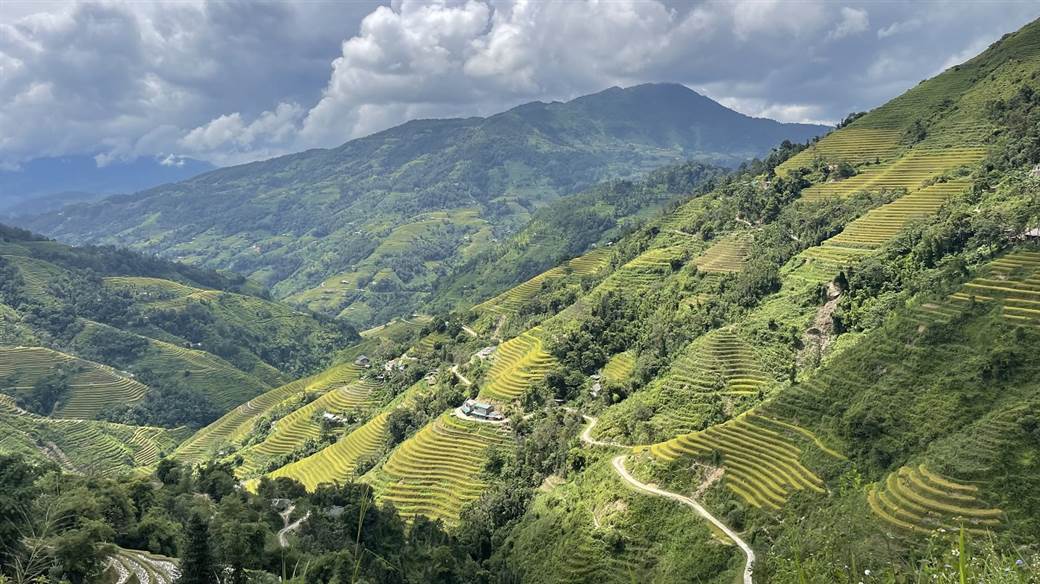
Five-Colored Sticky Rice: An Exquisite Art of Highland Cuisine
2. Top 4 Rice Fields in Vietnam You Must Visit
Vietnam boasts several regions famous for their rice terraces, each with distinct characteristics and seasonal beauty. These agricultural wonders stretch across the northern highlands, with some of the most spectacular examples becoming internationally recognized tourism destinations. Phieu Travel has carefully selected the most impressive locations based on both scenic value and accessibility for visitors.
2.1 Mu Cang Chai: The Iconic Terraces of Yen Bai Province
Mu Cang Chai district in Yen Bai Province hosts Vietnam’s most photographed and celebrated rice terraces. Located about 280 kilometers northwest of Hanoi, these 2,200 hectares of terraced fields have been recognized as national heritage sites. The H’mong ethnic minority has cultivated these mountainsides for centuries, creating a landscape of unparalleled beauty that transforms dramatically with each season. The terraces here are particularly steep and densely packed, creating mesmerizing ripple effects that seem to flow endlessly down the mountains.
The most famous viewpoints in Mu Cang Chai have become destinations in their own right. La Pan Tan village offers panoramic views of vast terraced valleys that stretch to the horizon, with early morning fog creating dreamlike scenes. Mam Xoi Hill (Sticky Rice Hill) presents perhaps the most iconic rice terrace image in Vietnam perfectly curved terraces resembling a giant’s staircase climbing toward the sky. Mong Ngua (Horse Hoof) provides dramatic curved terraces that wrap around mountainsides, with wooden stilt houses perched among them for scale and cultural context. These prime viewpoints become crowded during harvest season but remain breathtaking year-round.
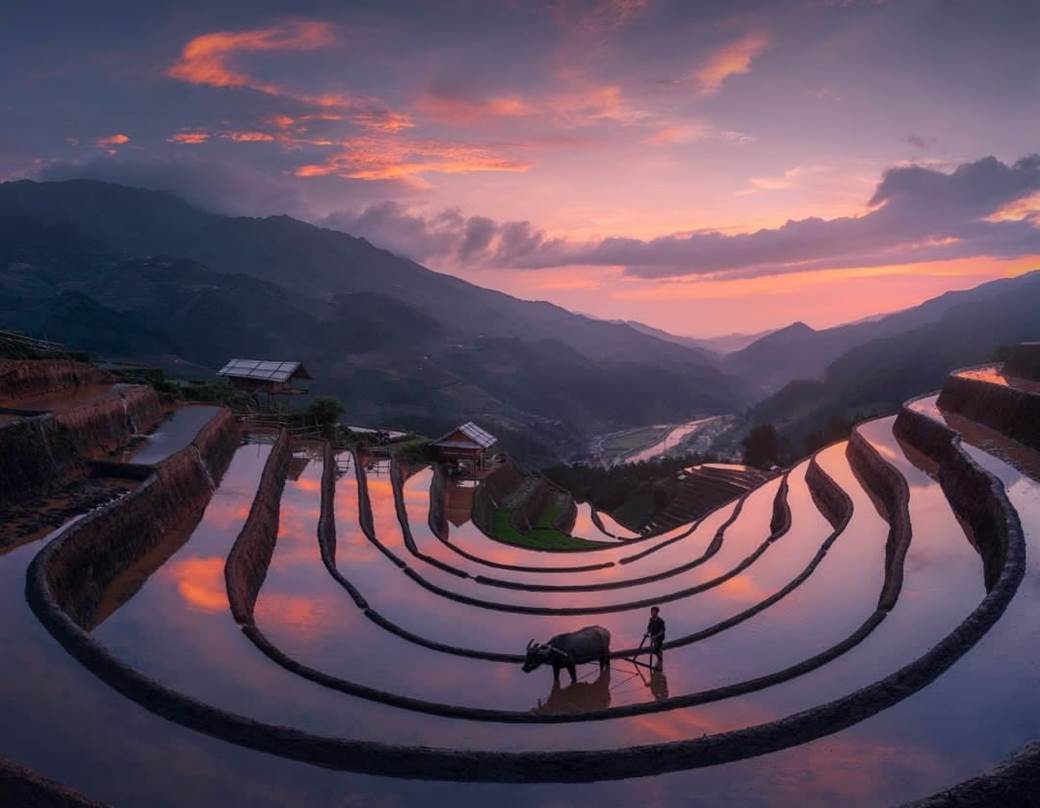
Exploring Mu Cang Chai – Ha Giang: Where to Go, What to Eat, and Where to Stay
2.2 Sapa: Accessible Beauty in Lao Cai Province
Sapa in Lao Cai Province combines magnificent rice terraces with well-developed tourism infrastructure, making it the most accessible option for many travelers. The region’s terraces cascade down the slopes of the Hoang Lien Son mountain range, including Fansipan Indochina’s highest peak. The Muong Hoa Valley between Sapa town and the villages of Lao Chai and Ta Van offers some of Vietnam’s most photographed landscapes, with terraces stretching in every direction beneath towering mountains often shrouded in mist.
What makes Sapa’s terraces unique is their setting amid exceptional biological diversity and ethnic cultural richness. The Red Dao, Black H’mong, and Giay people maintain these fields while preserving their distinct traditions, colorful attire, and craftsmanship. Visitors can combine rice terrace viewing with authentic homestays, handicraft shopping, and cultural interactions. The relatively easy access just an overnight train or six-hour drive from Hanoi makes Sapa perfect for travelers with limited time but doesn’t diminish the spectacular beauty of its cascading fields between cloud-touched mountains.
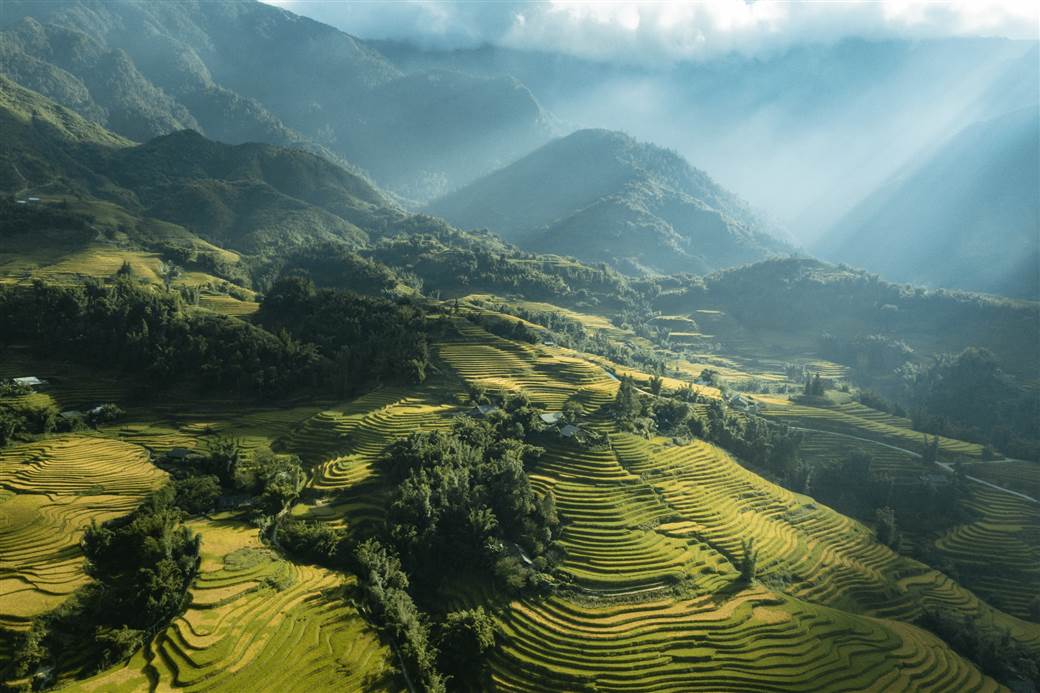
Ha Giang Loop vs Sapa? The Ultimate Guide for Solo Adventurers in Northern Vietnam
2.3 Hoang Su Phi: Remote Grandeur in Ha Giang Province
Hoang Su Phi in Ha Giang Province represents the road less traveled for rice terrace enthusiasts. These terraces stretch across seven communes and were recognized as national heritage sites in 2012. The Ban Luoc, San Sa Ho, and Nam Ty communities maintain some of the oldest terraced fields in Vietnam, with systems dating back over 300 years. The remoteness of this region about 300 kilometers from Hanoi with challenging mountain roads has preserved both the pristine landscape and the authentic cultural practices of the Red Dao, Nung, and La Chi ethnic groups.
The terraces of Hoang Su Phi are characterized by their enormous scale and dramatic setting. Rather than small, densely-packed steps, these terraces often sweep in grand curves that follow the natural contours of entire mountainsides. Their remote location means fewer tourists, creating opportunities for solitary contemplation of these agricultural masterpieces. The challenging journey rewards visitors with untouched vistas and encounters with communities maintaining traditional lifestyles largely unchanged by modern tourism. For photographers seeking unique perspectives beyond the well-documented sites, Hoang Su Phi offers fresh creative opportunities.
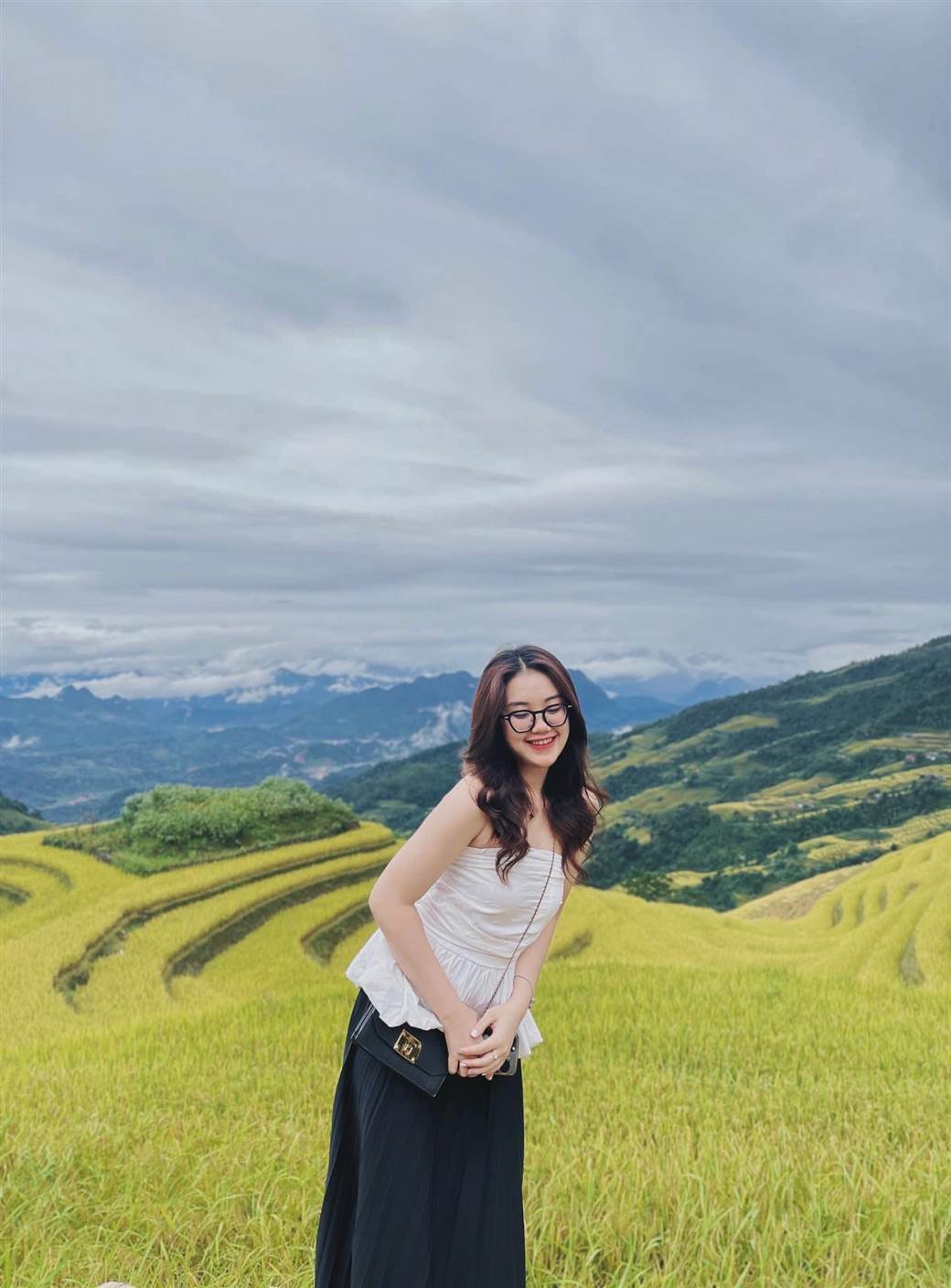
2.4 Other Scenic Regions Worth Exploring
Beyond the famous trio of Mu Cang Chai, Sapa, and Hoang Su Phi, Vietnam harbors several lesser-known but equally magnificent rice terraces. Y Ty in Lao Cai Province sits at high elevation near the Chinese border, with terraces often floating above sea of clouds. Pu Luong Nature Reserve in Thanh Hoa Province combines rice terraces with limestone formations and primary forests in a biosphere reserve setting. Ninh Binh, better known for its limestone landscapes, surprises visitors with beautiful rice fields nestled among karst towers.
For adventurous travelers willing to venture further south, the Central Highlands offer distinctive terraced landscapes. Kon Tum and Gia Lai provinces feature terraces maintained by Xe Dang and Ba Na ethnic groups with techniques different from northern counterparts. These southern terraces follow different growing schedules, offering harvest scenes when northern fields might be bare. With Phieu Travel’s connections throughout Vietnam, we can arrange visits to these overlooked gems where tourism remains minimal and landscapes maintain their pristine character.
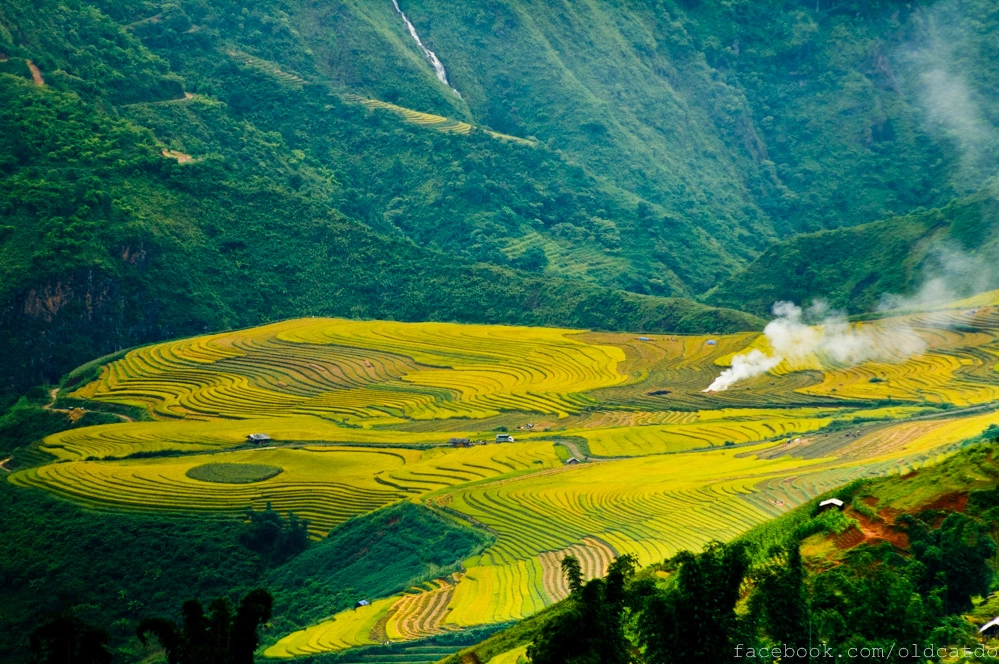
3. When to Visit: Rice Terrace Seasons Explained
The appearance of Vietnam’s rice terraces transforms dramatically throughout the year, with each season offering a completely different visual experience. Understanding this agricultural calendar helps visitors plan trips that align with their preferred aesthetic whether that’s reflective water, lush green growth, or golden harvest scenes. While specific timing varies slightly by region and annual weather patterns, Phieu Travel can help you coordinate your visit for optimal viewing conditions.
3.1 Water Season (Planting)
The water season typically begins in late May through June when farmers flood the terraces to prepare for rice planting. During this brief but spectacular phase, the mountains appear to be decorated with thousands of mirrors reflecting the sky. Early morning and late afternoon present the most dramatic scenes as low-angle sunlight creates spectacular reflections. The terraces take on a silvery-blue appearance that completely transforms the landscape from its more familiar green or golden states.
This season offers unique photographic opportunities but requires precise timing. The flooding period lasts only about two weeks in each area before planting begins. Visiting during this phase allows you to witness farmers wading through fields, transplanting young rice seedlings by hand a practice that has remained unchanged for centuries. Local communities become especially active during planting, creating opportunities to observe traditional agricultural techniques and perhaps even participate in the process. The weather during this season tends to be warm but with frequent mountain showers that create atmospheric mist effects.
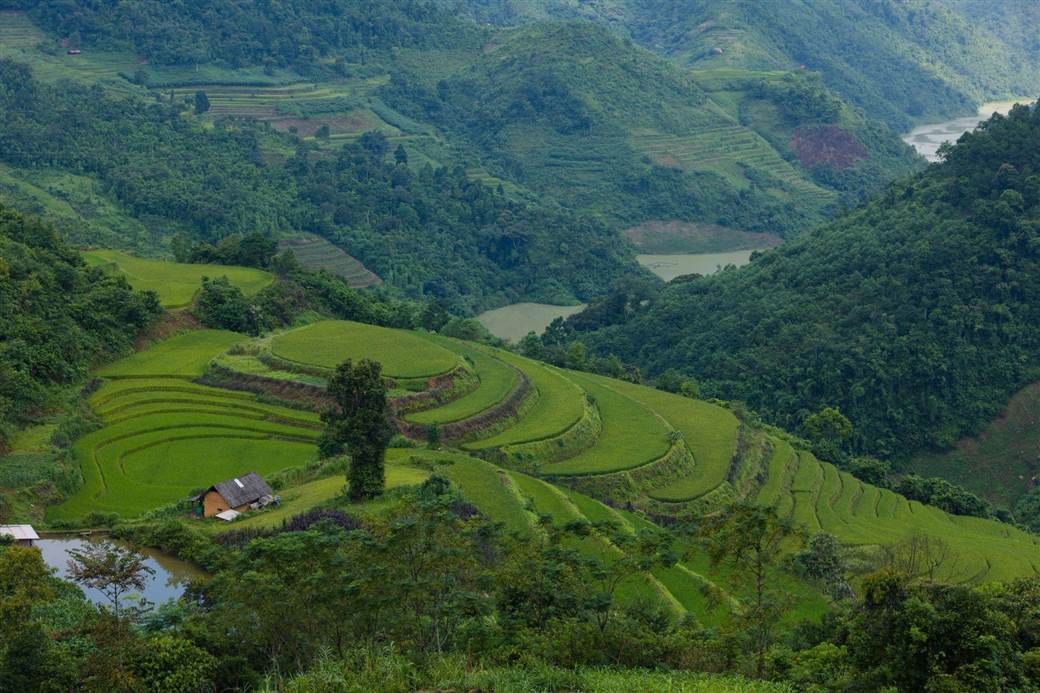
Visiting Ha Giang in June: Weather, Itinerary & Must-See Sights
3.2 Green Season (Growing)
From July through early September, the rice plants grow rapidly, covering the terraces in vibrant green carpets of varying shades. This lush period transforms mountainsides into cascading waves of green that change tone as they catch different angles of light. The green season combines beautiful landscapes with pleasant weather, making it ideal for trekking and extended photography sessions. During this period, the mountains are at their most vibrant, with wildflowers blooming alongside paddies and frequent clear skies providing excellent visibility.
What makes the green season special is the dynamic nature of the landscape. Young rice presents a bright, yellowish-green that deepens to emerald as plants mature. Fields planted at slightly different times create patchworks of varied green tones across the mountains. This season also coincides with summer holidays for many international travelers, offering good accessibility and weather conditions for mountain exploration. Though less famous than the golden harvest, this verdant period offers equally stunning beauty with significantly fewer tourists crowding popular viewpoints.
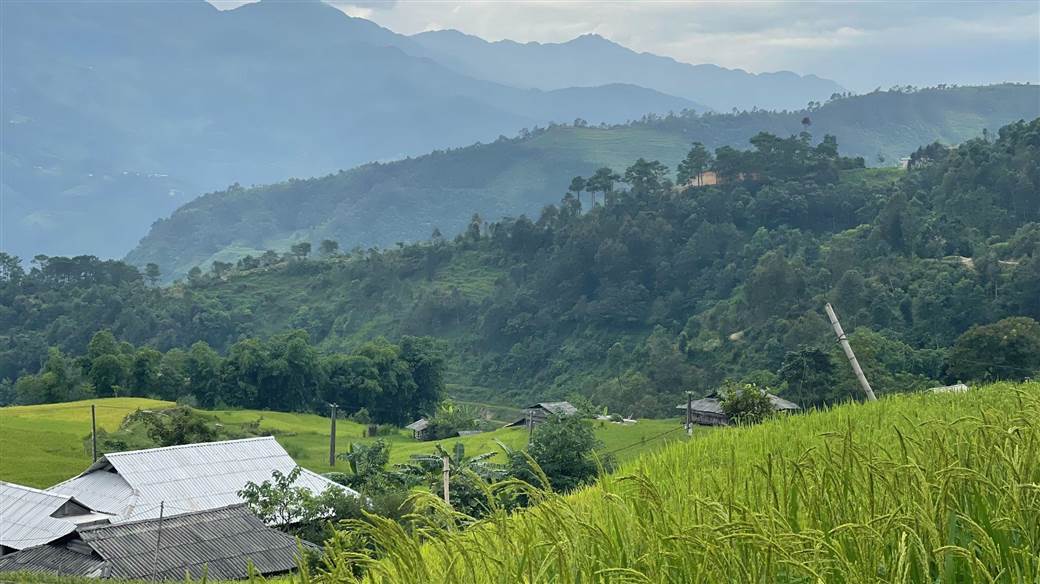
3.3 Golden Season (Harvest/Photography)
September through early October brings the famous golden season, when rice plants mature and turn a magnificent yellow-gold color before harvest. This is the iconic period that appears on postcards and travel magazine covers. The terraces transform into flowing rivers of gold that seem to cascade down mountainsides. This visual spectacle draws photographers from around the world, particularly to Mu Cang Chai where the harvest coincides with an annual cultural festival celebrating the region’s terraced heritage.
The golden season is the peak of rice terrace beauty, but also the busiest time for visitors. The harvest period is relatively brief, lasting only 2-3 weeks in each region as fields ripen at slightly different times depending on elevation and variety. The weather during this season is typically ideal cool, clear, and stable perfect for hiking between viewpoints. Early morning fog often creates magical scenes as golden terraces emerge from misty valleys. Phieu Travel recommends booking accommodation well in advance for this period, especially in popular areas like Mu Cang Chai where facilities are limited.
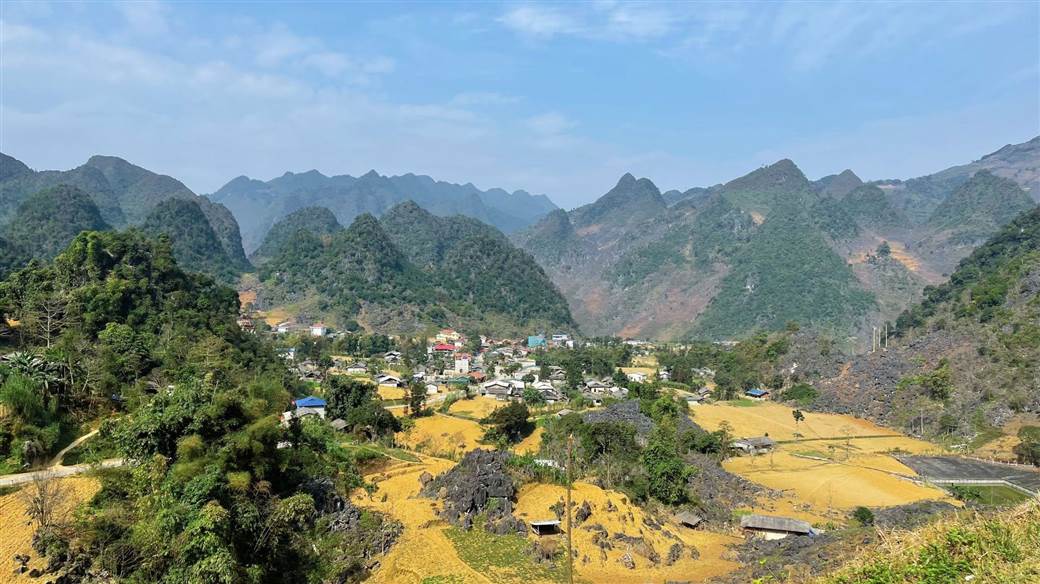
Ha Giang weather in October: climate, best time to visit & tips
4. How to Get There & Itinerary Planning
Reaching Vietnam’s rice terraces requires some planning, as most are located in mountainous regions with varying degrees of accessibility. Transportation options range from organized tours to independent travel by train, bus, or motorbike. Phieu Travel specializes in creating custom itineraries that balance spectacular views with comfortable travel experiences based on your preferences and available time.
4.1 Transport Options (Trains, Buses, Motorbike)
Overnight trains offer a comfortable and scenic route to Lao Cai (for Sapa), with sleeper berths allowing you to arrive refreshed. The journey takes approximately 8 hours from Hanoi, with daily departures in the evening and morning returns. This option provides good value and allows you to maximize daylight hours at your destination. Public buses serve all major terrace regions, with VIP options offering more comfort for the winding mountain roads. The journey takes 5-7 hours to Sapa, 7-8 hours to Mu Cang Chai, and 8-10 hours to Ha Giang (for Hoang Su Phi).
For adventurous travelers, motorbike tours represent the most flexible and immersive option. Riding through mountain passes provides unscheduled stops at breathtaking vistas and encounters with local communities away from tourist centers. Phieu Travel can arrange quality motorbike rentals with safety equipment and experienced guides who know the best secret viewpoints. For those with limited time or riding experience, private car hires with knowledgeable drivers offer comfort while maintaining flexibility to stop at photogenic spots along the route. These private transfers can be arranged for groups of any size, with vehicles ranging from sedans to minivans.
4.2 Suggested Routes from Hanoi & Major Cities
From Hanoi, the classic northern circuit connects multiple rice terrace destinations in a logical sequence. A 10-day itinerary might begin in Sapa (2-3 days), continue to Mu Cang Chai (2 days), then loop through Hoang Su Phi and the broader Ha Giang region (4-5 days) before returning to Hanoi. This comprehensive route showcases diverse terraced landscapes and multiple ethnic cultures but requires comfortable travel time. Those with limited schedules can focus on Sapa for a weekend trip, accessible via overnight train or a single day’s drive.
For travelers arriving in Ho Chi Minh City, domestic flights connect to Hanoi in just over two hours, allowing quick access to northern terraces. Alternatively, those exploring central Vietnam can incorporate Pu Luong’s terraces as a natural extension from Ninh Binh or Thanh Hoa. Phieu Travel can arrange seamless connections between regions, including luggage transfers and accommodation bookings that maximize viewing opportunities at different times of day. Our flexible itineraries adapt to weather conditions, allowing schedule adjustments to capture the best light and visibility for photography or simply peaceful enjoyment of these remarkable landscapes.
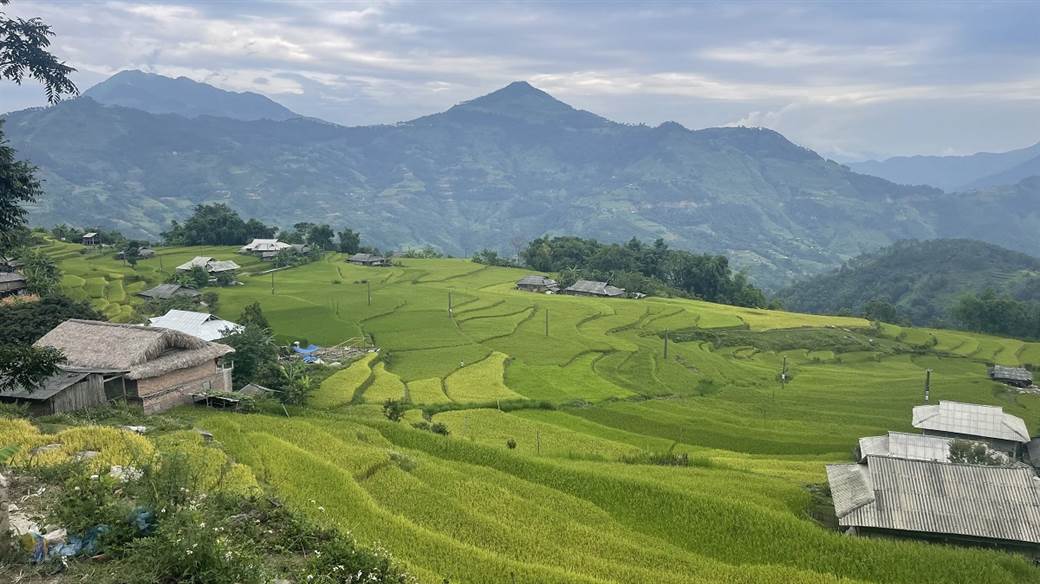
Ha Giang Loop cost guide 2025: real prices, tour options & savings
5. Essential Travel Tips & Activities
Beyond simply viewing the terraces, numerous activities enhance your rice field experience. From photography workshops to cultural immersions and hiking adventures, these complementary experiences provide deeper connection to both the landscape and the communities who create it. Phieu Travel can arrange specialized activities suited to your interests, physical abilities, and time constraints.
5.1 Photography Tips and Best Viewpoints
For capturing stunning rice terrace images, timing is everything. The golden hours after sunrise (5:30-7:30am) and before sunset (4:30-6:30pm) provide dramatic lighting that accentuates the terraces’ contours. Pack a tripod for low-light conditions and graduated neutral density filters to balance bright skies with darker foregrounds. A wide-angle lens captures sweeping panoramas, while a telephoto helps isolate patterns and details. Consider including human elements farmers, buffalo, or traditional architecture to provide scale and cultural context to the vast landscapes.
The most rewarding viewpoints often require some effort to reach. In Mu Cang Chai, the road between Che Cu Nha and La Pan Tan villages offers elevated perspectives worth the challenging drive. Near Sapa, the bamboo forest viewpoint above Ta Van provides unique framing for the terraces below. In Hoang Su Phi, the road between Nam Ty and Thong Nguyen reveals expansive views after each mountain pass. Phieu Travel guides know precisely when each location receives optimal light and can position you perfectly as conditions change throughout the day.
5.2 Trekking and Local Experiences
Guided treks through rice terraces offer intimate experiences impossible from roadside viewpoints. Half-day walks connect villages while following ancient footpaths along terrace edges. Full-day adventures reach remote communities where traditional harvesting methods continue unchanged for centuries. Multi-day treks allow deeper exploration with homestay accommodations in ethnic minority villages. These walks vary in difficulty but always provide unique perspectives on agricultural practices while creating opportunities for meaningful cultural exchange.
Beyond trekking, immersive cultural experiences deepen your connection to these landscapes. Cooking classes teach traditional recipes using fresh ingredients from nearby fields. Craft workshops demonstrate indigo dyeing, hemp weaving, or silver smithing with artisans from H’mong and Dao communities. Participating in seasonal activities from rice planting to harvest offers hands-on understanding of the agricultural cycle. Evening music performances feature traditional instruments and songs that celebrate the relationship between people and land. Through these experiences, visitors gain appreciation for the cultural context that makes these terraces not just beautiful views but living heritage.
5.3 Where to Stay and What to Eat
Accommodation options in rice terrace regions range from basic homestays to comfortable ecolodges and boutique hotels. Traditional homestays in Tay, Dao, or H’mong villages offer authentic cultural immersion with simple amenities typically a mattress on the floor, mosquito net, and shared bathroom. Mid-range ecolodges blend traditional architecture with modern comforts, offering private rooms with hot showers while maintaining cultural authenticity. In larger towns like Sapa, boutique hotels provide luxury amenities with terraced rice field views from private balconies.
Culinary experiences in these regions showcase distinctive highland flavors. Must-try dishes include thang co (hearty H’mong stew with mountain herbs), cơm lam (bamboo-cooked sticky rice), grilled stream fish, and fresh mountain vegetables prepared with minimal seasoning to highlight natural flavors. Local rice wine (rượu) made from corn, cassava, or sticky rice varies by ethnic group and often accompanies meals as both beverage and hospitality gesture. Markets in Sapa, Mu Cang Chai town, and Ha Giang city offer colorful displays of regional produce, allowing visitors to sample seasonal fruits and traditional snacks while observing local trading customs.
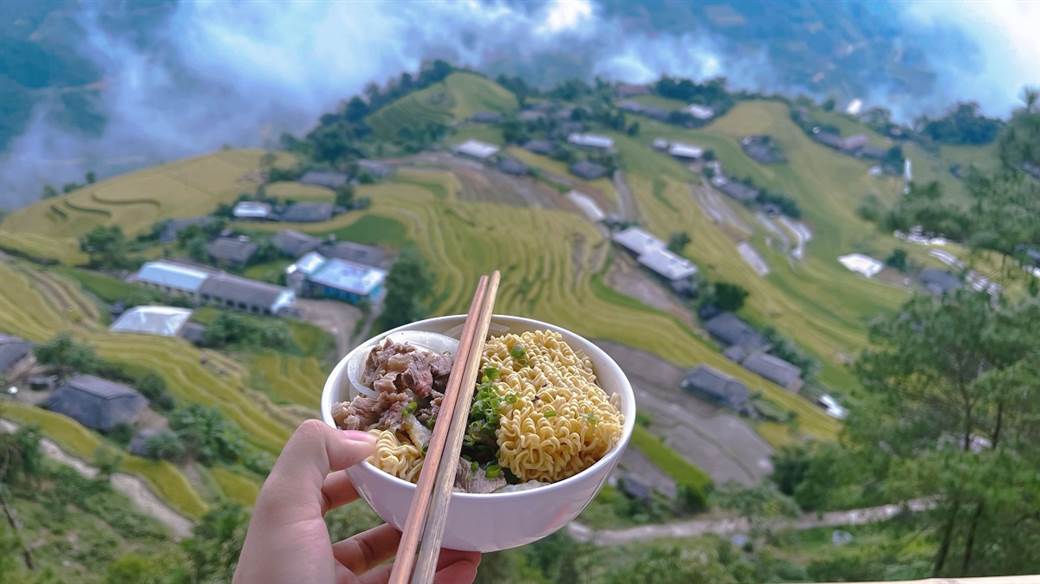
6. Rice Terraces FAQs
When planning a visit to Vietnam’s terraced landscapes, travelers naturally have many questions about timing, access, and expectations. These frequently asked questions address the most common inquiries we receive at Phieu Travel, helping you prepare for an unforgettable rice terrace experience.
When is the best time to visit the rice terraces in Vietnam?
The best time depends on which visual experience you prefer. For mirror-like water reflections, visit in late May to early June during the flooding season. For lush green landscapes, July through early September offers vibrant growing fields. The iconic golden harvest scenes are best witnessed from mid-September to early October, particularly in Mu Cang Chai and Hoang Su Phi. Sapa’s harvest comes slightly earlier, usually beginning in early September. Each season offers completely different but equally beautiful landscapes.
What are the most famous rice terrace locations in Vietnam?
Mu Cang Chai in Yen Bai Province features Vietnam’s most photographed terraces, particularly around La Pan Tan village and Mam Xoi (Sticky Rice) Hill. Sapa’s terraces are the most accessible, with Muong Hoa Valley between Lao Chai and Ta Van villages offering spectacular views. Hoang Su Phi in Ha Giang Province provides more remote but equally impressive terraced landscapes. Less famous but worth visiting are Y Ty (Lao Cai), Pu Luong (Thanh Hoa), and Che Cu Nha (Yen Bai), which offer similar beauty with fewer tourists.
How do I get to the rice fields in Mu Cang Chai, Sapa, and Hoang Su Phi?
Sapa is reached via overnight train or bus from Hanoi to Lao Cai, followed by a 45-minute transfer. Direct buses also connect Hanoi to Sapa in 5-6 hours. Mu Cang Chai requires a 7-8 hour bus journey from Hanoi or can be visited as part of a loop from Sapa (3-4 hours by road). Hoang Su Phi is accessed through Ha Giang city, about 8 hours from Hanoi by bus, followed by another 3-4 hours on mountain roads. Private transportation offers more comfort for these journeys, while motorbike tours provide the greatest flexibility for stopping at viewpoints.
What do the rice fields look like in different seasons?
The terraces transform dramatically throughout the year. During planting season (May-June), flooded terraces create mirrored surfaces reflecting the sky and clouds. The growing season (July-August) brings vibrant green carpets that become progressively deeper in tone as plants mature. Harvest season (September-October) turns the mountains golden-yellow in spectacular displays that attract photographers worldwide. Post-harvest (November-April), the terraces appear as sculptural forms in the landscape, sometimes dusted with frost or occasional snow in the highest regions during December and January.
Are Vietnam’s rice terraces easy to visit for independent travelers?
The accessibility varies by region. Sapa’s terraces are quite accessible for independent travelers, with good tourism infrastructure and easy transportation from Hanoi. Basic English is widely spoken, and many local guides are available. Mu Cang Chai and Hoang Su Phi present more challenges, with limited tourism facilities and transportation options. A basic grasp of Vietnamese or a translation app proves helpful in these areas. For all regions, navigating narrow mountain roads can be challenging, especially in rainy conditions. Phieu Travel recommends guided tours for first-time visitors to these more remote areas.
What should I bring or prepare for a trip to the rice fields?
Essential items include good hiking shoes with grip for muddy paths, light rainwear even in dry seasons, sun protection, and layers for variable mountain temperatures. A small backpack helps carry water and essentials during hikes between villages. For photography, bring a polarizing filter to manage reflections and enhance colors, plus spare batteries as charging opportunities may be limited in remote areas. Cash is important as ATMs are scarce outside major towns, and most small vendors do not accept cards. Finally, learning a few basic Vietnamese phrases shows respect for local communities and enhances your experience.
The terraced rice fields of Vietnam represent one of Southeast Asia’s most breathtaking landscapes living testimony to centuries of agricultural innovation and cultural perseverance. These cascading green and gold masterpieces aren’t just agricultural systems but the beating heart of highland communities and an increasingly precious resource in a changing climate. Whether you’re photographing golden harvests in Mu Cang Chai, trekking between H’mong villages in Sapa, or discovering hidden viewpoints in Hoang Su Phi, these rice field experiences in Vietnam will remain etched in your memory long after your journey ends.
For expert guidance through Vietnam’s terraced wonderlands, including customized itineraries timed perfectly for your preferred season, contact us at Phieutravel.com. Our specialized knowledge of Vietnam’s rice fields ensures an experience that balances iconic views with authentic cultural encounters, creating travel memories that transform how you see both landscape and human ingenuity.
Read more:
- Top 20 Ha Giang homestays with scenic views (2025)
- Worst time to do the Ha Giang Loop safety stories 2025
- Ha Giang weather by month complete local guide for travelers
- Things to buy in Vietnam the complete traveler’s shopping guide
- Best time to visit Vietnam ultimate guide by region, month & travel type
- Ha Giang Weather in September: Complete Guide for Travelers

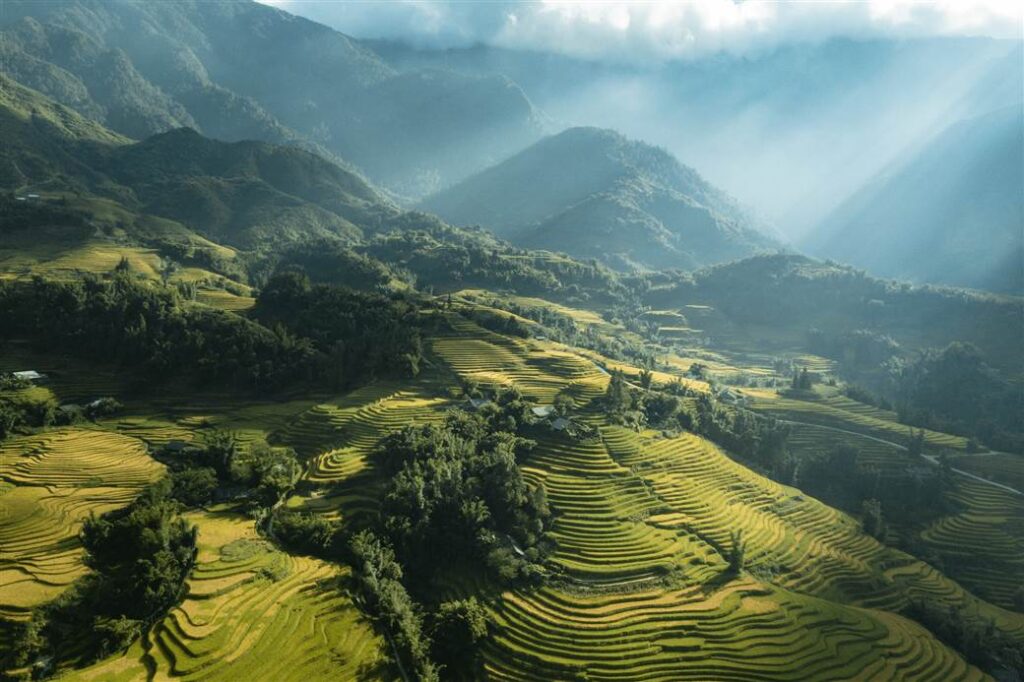
You Might Also Like
Ha Giang Weather in September: Complete Guide for Travelers
Exploring the magnificent Ha Giang Loop in September offers travelers a perfect balance of favorable[...]
Quan Ba Twin Mountains: Ha Giang’s Iconic Fairy Hills and Complete Travel Guide
The mystical Quan Ba Twin Mountains rise from the emerald valleys of Ha Giang like[...]
Vuong family mansion: the architectural marvel and cultural legacy of Ha Giang
Deep in Vietnam’s northern highlands, where mist-shrouded mountains meet terraced rice fields, stands a testament[...]
Ha Giang Loop Safety Tips: How to Ride Securely in Vietnam’s Northern Mountains
The Ha Giang Loop, with its winding mountain roads and breathtaking landscapes, offers one of[...]
The Ultimate Guide to the M-Shaped Curve on Ha Giang Loop
Vietnam’s remote northern province of Ha Giang hides a natural wonder that has captivated adventurous[...]
Most Beautiful Places to Visit in Vietnam: Essential Destinations and Insider Tips
Vietnam captivates travelers with its stunning landscapes, rich cultural heritage, and warm hospitality. From mist-shrouded[...]
Beyond the Beaten Path: Discovering Ha Giang Province in Northeast Vietnam
Ha Giang Province in Northeast Vietnam stands as one of the country’s last frontiers for[...]
Rainy season in Ha Giang: what to expect, when to go, and travel tips
Vietnam’s northern frontier reveals a different face during the rainy season, transforming Ha Giang’s limestone[...]